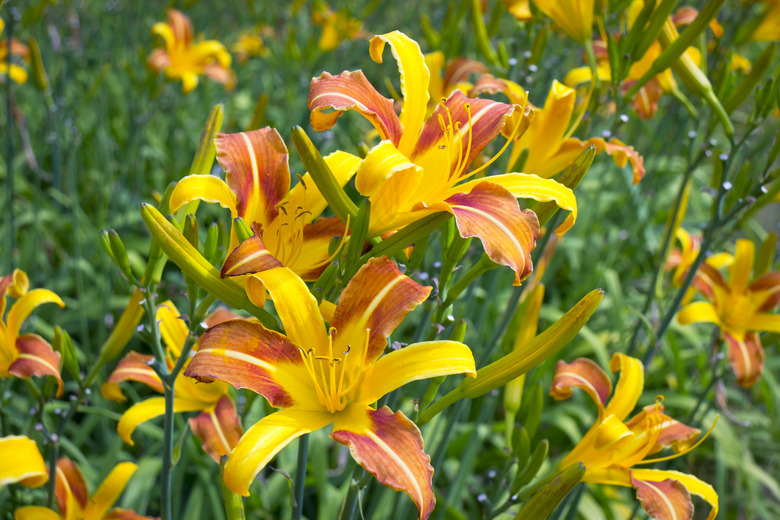Why Day Lilies Don't Bloom
Day lilies (Hemerocallis spp.) usually bloom for three to four weeks, but shade, drought, too much fertilizer or crowding can prevent flowering. These perennials grow in upright clumps 6 to 36 inches tall and 18 to 24 inches wide, and grow in U.S. Department of Agriculture plant hardiness zones 3 through 9, depending on the variety. Selecting day lilies that thrive in the growing conditions in your garden gives the best chance of plentiful blooms.
Shady Spots
Day lilies growing in shady spots flower rarely or not at all. These plants flower best in sites that receive eight hours of direct sunlight per day. Day lilies grow healthily in partially shaded sites, but you'll see fewer flowers.
- Day lilies (Hemerocallis spp.)
- Day lilies grow healthily in partially shaded sites, but you'll see fewer flowers.
Grow day lilies in an area of the garden that receives at least six hours of sun. In mild and cold climates, such as USDA zones 7 and lower, there's no maximum amount of sunlight day lilies can tolerate. In USDA zones 8 and above, the plants grow and flower best with light shade, such as from a high canopy, at midday and into the afternoon. If your day lilies are growing in a shady site, remove overhanging branches and other sources of shade, or consider transplanting the plants to a brighter part of the yard.
Dry Soil
Dry soil and periods of drought prevent flowering in day lilies. Plump roots mean day lilies can survive dry soil and drought, but the plants often lose their flower buds in these conditions.
Moist soils rich in organic matter are best for growing day lilies. Spread a 3-inch layer of garden compost, leaf mold or well-aged manure around the plants, but don't pile the mulch against the day lily stems because this can cause rotting. Over time, worms and other soil organisms will break the mulch down and enrich the soil.
- Grow day lilies in an area of the garden that receives at least six hours of sun.
- In mild and cold climates, such as USDA zones 7 and lower, there's no maximum amount of sunlight day lilies can tolerate.
- If your day lilies are growing in a shady site, remove overhanging branches and other sources of shade, or consider transplanting the plants to a brighter part of the yard_.
- Dry soil and periods of drought prevent flowering in day lilies.
Water day lilies when the soil surface is dry. Spray water from a garden hose fitted with a soft spray attachment at the plant bases to penetrate dense clumps. Stop watering when the water begins to puddle on the soil surface.
Excessive Fertilizer
Day lilies don't need much fertilizer, and excessive fertilizer can encourage leafy growth at the expense of flowers. Plants getting too much fertilizer often have lush, deep green leaves and look healthy but won't flower. Day lilies growing in a border next to a lawn can accidentally receive lawn fertilizer.
Don't fertilize day lilies that look healthy but aren't flowering and don't spread lawn fertilizer within 2 feet of day lilies.
- Water day lilies when the soil surface is dry.
- Don't fertilize day lilies that look healthy but aren't flowering and don't spread lawn fertilizer within 2 feet of day lilies_.
Crowded Plants
Dividing crowded day lilies encourages strong growth and flowering. Reduced blooming is a sign that day lilies need dividing. This can happen every two or three years or up to every 20 years, depending on the variety. You can divide day lilies at most times of the year, but the usual time for dividing plants is spring before new growth starts.
Dig up day lily clumps with a garden fork, and split each clump into three or four sections. You can do this by pushing two garden forks down through the leaves and into the root ball, then levering the garden forks apart, or you can cut through the root ball with a sharp, clean knife. Plant the sections at their original growing depth and 18 to 24 inches apart.
- Dividing crowded day lilies encourages strong growth and flowering.
- You can divide day lilies at most times of the year, but the usual time for dividing plants is spring before new growth starts.
